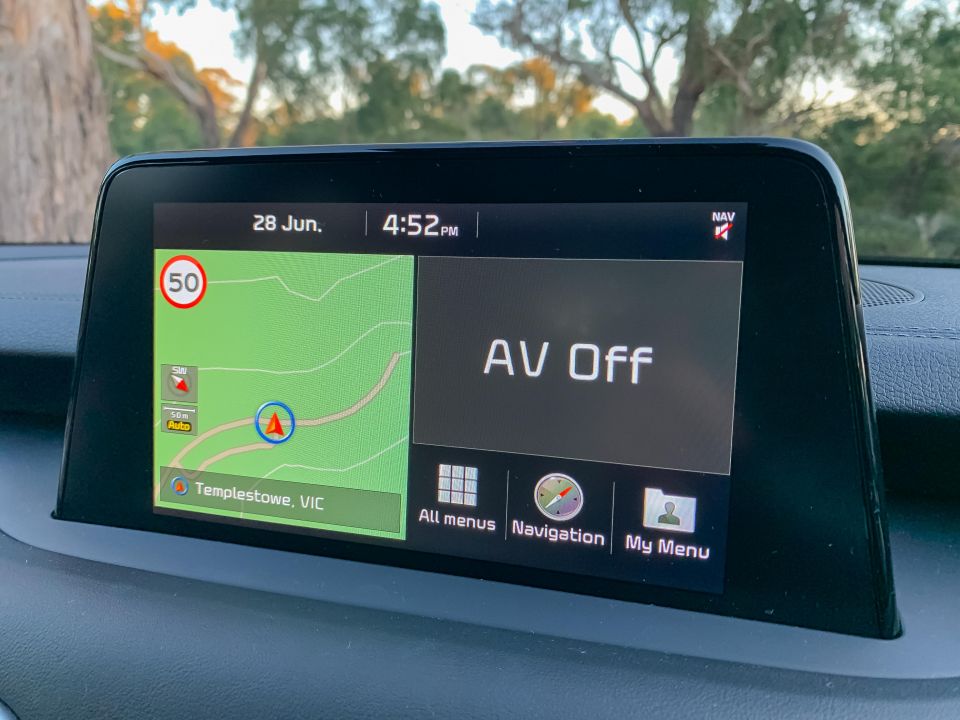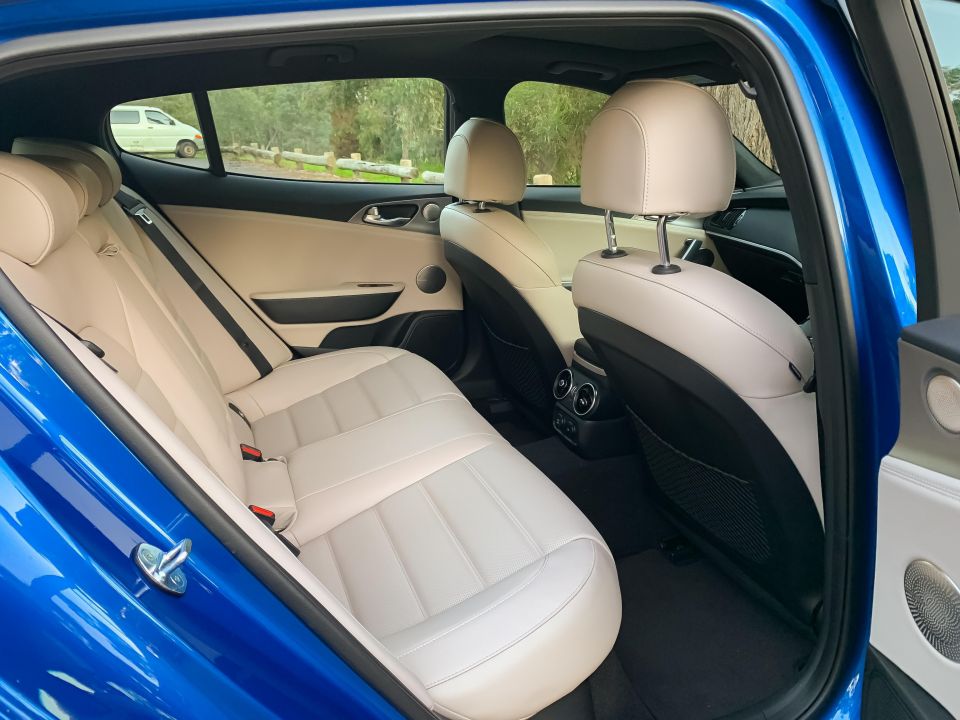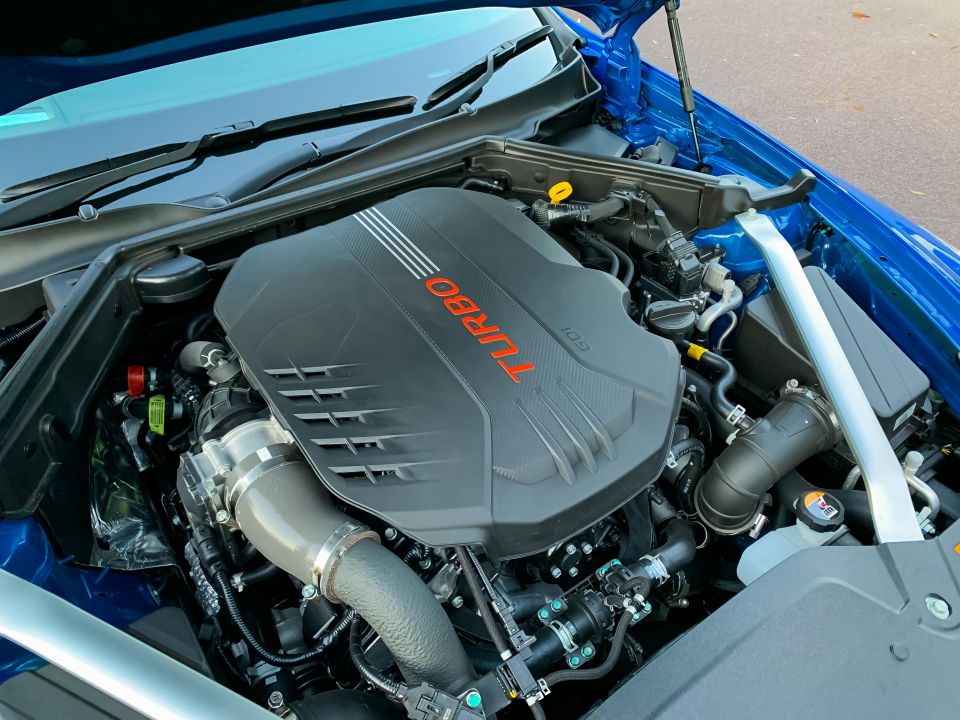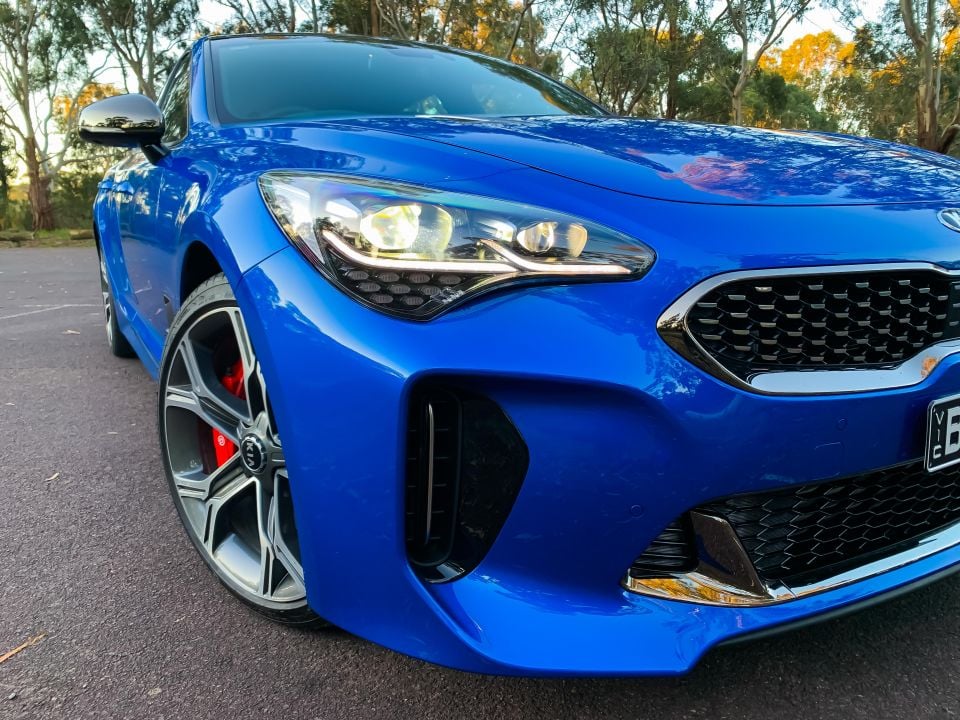

James Wong
2025 Kia EV5 Earth AWD review
4 Days Ago
The Kia Stinger GT is still one of the best bang-for-buck performance buys, and the Night Sky Edition adds a touch of class and rasp to the experience.



Marketplace Editor
New from
$46,990
excl. on-roads

Marketplace Editor
New from
$46,990
excl. on-roads


Marketplace Editor
New from
$46,990
excl. on-roads

Marketplace Editor
New from
$46,990
excl. on-roads
Quickly see how this car stacks up against its competition. Select any benchmark to see more details.
Where expert car reviews meet expert car buying – CarExpert gives you trusted advice, personalised service and real savings on your next new car.
Few cars can spark controversy the same way the Kia Stinger can. Since launch in 2017 it’s been the topic of fierce debate in the comments sections of various motoring websites, as well as social media.
While many question whether it’s a ‘proper’ successor to the Australian-made V8 Commodore and Falcons of years past, or whether it truly is a cut-price alternative to German fastbacks like the Audi A5/S5 or BMW 4 Series, the Stinger’s strengths in general rarely merit a mention.
Here on test we have the Stinger GT Night Sky Edition, a limited-run model that gets some exclusive interior trim and the Kia Australia-developed bi-modal sports exhaust as standard.
Clearly in this guise it’s gunning for the sports-luxe establishment, so how does it fare with a facelifted model on the way?


The MY20 Kia Stinger GT Night Sky Edition is priced from $63,700 before on-road costs, making it $2710 more than the ‘standard’ Stinger GT. Kia Australia is currently advertising a national drive-away price of $67,190 drive-away, with 2.0 per cent comparison rate finance.
That near-$3000 premium over the regular Stinger GT is made up of the additional cost of the bi-modal exhaust system, which usually wears a price tag of $3135.92 on other models including fitment. A small discount, but a win nonetheless.
Our test car had no paid options fitted, as the Micro Blue metallic seen here is a no-cost option. However, there’s also Deep Chroma Blue metallic and Aurora Black pearl exterior finishes available for $695. There’s no other options.



As mentioned earlier, the GT Night Sky Edition picks up the bi-modal sports exhaust and model-specific light grey nappa leather upholstery over the standard Stinger GT.
From the model on which it’s based, the Kia Stinger we have here also gets adaptive dampers, a 360-degree parking camera system, 19-inch alloy wheels wrapped in Michelin Pilot Sport 4 tyres, a colour head-up display, heated and ventilated front seats, power front seats with driver memory, an electric steering column, a power tilt/slide sunroof, an electric tailgate, black suede headliner, a 15-speaker harman/kardon premium sound system, wireless phone charging, and a heated steering wheel.
There’s also full LED lighting front and rear with auto-levelling and active bending headlights, auto high-beam, blind-spot monitoring, rear cross-traffic alert, and a larger 7.0-inch driver’s instrument display with ‘GT’ interface.
Features from lower grades include an 8.0-inch touchscreen navigation system with wired Apple CarPlay and Android Auto, a mechanical limited-slip differential at the rear, Brembo brakes, paddle shifters, launch control, and a suite of driver assistance systems including low- and high-speed autonomous emergency braking (AEB), lane keep assist, driver attention alert, and adaptive cruise control with stop/go.
The list goes on and on. Long story short, the Stinger GT Night Sky Edition has just about everything Kia has to offer.

The Stinger was the topic of controversy when it was first release as ANCAP awarded base versions a paltry three-star safety rating as they lacked features like AEB and lane-keeping assist.
However, a specification upgrade in 2018 brought those features as standard and saw a 2017-stamped five-star rating applied across the range.
In crash tests conducted by Euro NCAP, the Kia Stinger scored 91 per cent for adult occupant protection, 81 per cent for child occupant protection, 78 per cent for pedestrian detection and 70 per cent for safety assist.
While a five-star result, Euro NCAP and ANCAP shared some key feedback regarding the Stinger’s crash performance which is worthy of note.

Rear passenger head and chest protection was rated ‘poor’ in audit tests conducted by ANCAP in 2018, while poor pelvis protection was recorded in the original Euro NCAP tests. Whiplash protection for rear occupants was also deemed ‘marginal’.
The Kia Stinger’s AEB system performed well in functionality tests, with the main safety assist penalty coming from the lack of a speed assistance system in Australia and New Zealand – losing three points out of 12 alone.
Dual frontal, side chest, side head-protecting (curtain) and driver knee airbags are standard, as is autonomous emergency braking (AEB) with forward collision warning, lane keep assist with lane departure warning, as well as blind-spot monitoring with rear cross-traffic alert.

Even a few years on from launch, you’ll be pleasantly surprised with the Stinger’s cabin presentation, particularly in GT guise.
The creamy leather trim is soft and supple, as is the flat-bottom steering wheel with contrast stitching, and everything you touch on the top- and mid-tiers of the cabin is finished in soft-touch materials.
It’s also just a nice design overall, drawing clear inspiration from the German luxury brands such as BMW’s 5 Series and Mercedes-Benz’s E-Class.
‘Aluminium and film’ trim adorns the centre console and door trims, while LED ambient interior lighting adds a touch of class at night, configurable in several colours. I chose blue to go with the exterior.



Kia’s in-house infotainment system brings the goods in terms of features, including wired Apple CarPlay and Android Auto, SUNA live traffic updates, DAB radio, and up to 10 years of MapCare, though the 8.0-inch screen is nothing special in this day and age and the lack of a fully-digital instrument binnacle is a minor drawback.
An upcoming facelift, due in Australia before the end of the year, should address this by bringing a 10.25-inch widescreen infotainment system and the option of a 12.3-inch virtual gauge cluster, and hopefully wireless Apple CarPlay. The wired system doesn’t allow a larger phone like my iPhone XS Max to sit in the wireless charger properly.
We really liked the 15-speaker harman/kardon system. It’s made up of eight speakers, four tweeters, a centre speaker and two subwoofers powered by an external amplifier. Audio is clear and rich, and if you turn the bass up just a little you can transform the Stinger into a rolling concert or nightclub.



The switchgear and controls all feel nicely damped and are nice to touch, reinforcing that perception of quality.
However, we’ve experienced a number of niggles with Kia Stinger press vehicles in years past, and this one was no different – though the issues were relatively small.
Our test car had a very annoying click/squeak sound coming from the sunroof, which got worse when you opened it. Something obviously was not fitted properly, which is pretty much unacceptable when it’s a near-$70,000 car with a couple of thousand kilometres on the clock.
That said, there weren’t any other issues with the exception of some shipping tape that hadn’t been removed from the front passenger door, so it looked like the shadow chrome frame ended at the B-pillar.



Hop into the second row and there’s a reasonable amount of space for average-sized adults, though six-foot-one-ish me found head- and legroom a little on the tighter side particularly behind my own driving position.
There’s a good amount of amenities back there, though, including rear air vents with manual temperature controls, 12V and fast-charge USB ports, a fold-down centre armrest with cupholders, and bottle holders in the doors.
Like the front, the nappa-trimmed seats are comfortable and supportive, and the soft-touch materials from the front doors are replicated in the second row. Other goodies include map pockets on the front seatbacks and ISOFIX mounts on the outboard pews for the kiddies and their booster seats.
One really odd omission is the lack of one-touch up/down windows for rear-seat passengers. Like, really Kia? If the Stinger is meant to challenge luxury brands one-touch windows all round should be a given.



Behind the electrically-operated tailgate is a 406L luggage area with all five seats in place. That certainly doesn’t sound like anything special on paper but the Stinger’s boot is wide and deep so there’s a good amount of capacity for shopping, prams or sports gear.
Should you need more load-lugging ability, the Stinger’s rear bench splits 60:40 to open up to 1114L of cargo capacity, which has a relatively flat floor and no obvious step up from the boot floor to the seat backs.
Under the boot floor is a space-saver spare wheel, but there’s no space to store the large and heavy cargo cover.

One of the Stinger’s key strengths (in V6 guise at least), is what lies under the bonnet.
Power comes from a 3.3-litre twin-turbocharged V6 developing a meaty 272kW of power at 6000rpm and 510Nm of torque from just 1300 to 4500rpm.
Kia officially claims a 0-100 sprint of 4.9 seconds on its way to a top-speed of 270km/h. Not bad.

For reference, to get that kind of performance from an equivalent Audi or BMW, you need to spend over $100,000 on an S5 or 440i. Food for thought.
Fuel consumption, meanwhile, is rated at 10.2L/100km on the combined cycle. The Stinger has a 60L fuel tank and is able to run on 91 RON regular unleaded – though we’d only be putting premium in to extract all the performance out of that twin-turbo V6.
Unlike versions offered overseas, Australian-delivered Kia Stingers miss out on idle stop/start tech, which claims to cut fuel use by up to 15 per cent in city driving.

Really well. I’ve long been a big fan of the Stinger because it looks and drives like a much more expensive car, and the Night Sky Edition takes that a step further largely thanks to the standard bi-modal exhaust.
From the moment you fire the twin-turbo V6 up there’s a rumbly, trumpety tone that sounds powerful and also special.
Get moving and the 510Nm is almost immediately at your disposal, considering it comes in just above idle at 1300rpm.
Around town the torquey engine and eight-speed auto are smooth and refined operators, gliding along while the engine purrs through the sports exhaust.
If you need to make a quick dash from the lights or make a gap in traffic there’s more than enough grunt on tap, it’s actually quite addictive. The high-pitched growl from the engine brings a smile to your face every time.

Where expert car reviews meet expert car buying – CarExpert gives you trusted advice, personalised service and real savings on your next new car.
The steering is relatively light and quick so manoeuvring the 4830mm long Stinger is surprisingly easy, and the surround-view cameras with front and rear sensors make parking a cinch – there’s even a kerb mode for both sides to you don’t scratch those pretty 19-inch rims.
It’s out on the open road where the Stinger belongs, though. Kia harped on about how it developed the Stinger at the famed Nurburgring in Germany, and to be honest you can feel the performance-skewed engineering once you hit a 110km/h freeway or high-speed winding country back road.
Regardless of speed, the Stinger feels planted and sure-footed. The front end feels pointy and sharp, turning in nicely and also able to change direction without much hassle despite being a 1780kg (tare) large fastback.
The sharp handling is combined with good body control and a firm but pliant ride, inspiring confidence when you’re feeling a bit enthusiastic while also being comfortable in normal driving.
We were quite impressed with overall refinement on the move, with wind and road noise well suppressed. The Michelin Pilot Sport 4 rubber does seem a little noisier than the Continental tyres fitted to other models, though the added grip is a worthy compromise.
You can really enjoy the exhaust note at higher speeds, too. The active valves seem to stay closed up until 3000rpm, and it’s quite noticeable when they open up and let the Stinger’s V6 engine sing. Actually, it sangs.
Annoyingly using the steering-mounted paddle shifters doesn’t give you a full manual mode to properly hold revs for as long as you want. Get to close to the limiter and the Stinger will shift up for you, and with traction control on you can’t activate the ‘track’ mode when the car is in its sportiest setting which doesn’t revert back to ‘Drive’ after a certain period of time with no shifts.
Regardless, the Stinger is so much fun to throw around a twisty back road. It has real dynamic capabilities and more than enough power than you’re ever going to need to have a bit of fun.
Just be mindful that in sport mode the traction control allows a tad more slip, so you might kick the rear out a little under hard acceleration out of a corner – which in a can be a little frightening for the uninitiated.
Like the wider Kia line-up, the Stinger is covered by the company’s industry-leading seven year, unlimited kilometre warranty with capped-price servicing and roadside assistance for that period.

Scheduled maintenance is required every 12 months or 10,000km – turbocharged petrol Kia models tend to have shorter intervals than naturally-aspirated petrols and diesels – with the first three visits asking for $336, $522 and $457.
The fourth and fifth services cost $776 and $378 respectively, and the sixth and seventh visits are $714 and $855. All up, the Kia Stinger will cost you $1315 over three years or 30,000km, $2469 for the first five years or 50,000km, and $4038 for the life of the seven-year servicing plan.
It’s certainly not cheap, and the service intervals are a bit short given most rivals (mainstream and premium) have 15,000-20,000km gaps between visits, but the seven-year warranty coverage with roadside assistance is unmatched.
We also saw an indicated 11.8L/100km after 424km of mixed driving. Not a bad result given the performance on offer but it’s still nearly 20 per cent up on the manufacturer’s claim and with more urban driving expect to see more 14s and 15s.

I’ve said it before and I’ll say it again – the Kia Stinger is a wonderful car.
Can it genuinely compete with European luxury rivals? For the most part, yes. Is it a proper alternative to the V8 Holden Commodores and Ford Falcons of yesteryear? Yes, it’s probably even better.
Truth be told the Kia Stinger is a very impressive bit of kit. For a ‘budget’ manufacturer like Kia to turn out such a capable all-rounder that also makes you look and feel special, it’s something of a miracle this car even exists.

Sure, there’s room for improvement – there continues to be little build quality issues that really need to be addressed, the infotainment displays could be more high-end and a proper manual mode for the transmission would be welcome – but given the price and what you get, there’s not a lot to complain about.
These complaints will hopefully be addressed with the mid-life facelift promised before the end of 2020.
The Night Sky Edition is even better again thanks to the beautiful grey interior, which I wish was an option for the regular GT like it is overseas. Gimme a Hichroma Red one with grey interior and bi-modal exhaust and you have an almost perfect family car.
If you’re in the market for something fast and a little bit different, don’t look at the badge and take it for a test drive – you won’t regret it.
Where expert car reviews meet expert car buying – CarExpert gives you trusted advice, personalised service and real savings on your next new car.
James is an automotive journalist based in Melbourne, Australia. Before joining CarExpert.com.au in 2020, James has worked at leading auto media outlets including Carsales and CarAdvice, as well as at Pulse agency for Ford Australia's communications team. In 2019 James made Mumbrella's 'Top 20 most prolific web authors in Australia' list after publishing 1,360 articles between March 1, 2018 and February 28, 2019 for CarAdvice. James is also an Ambassador for Drive Against Depression – an Australian charity whose mission is to support mental wellness through the freedom of driving and a shared love of cars.


James Wong
4 Days Ago


Angus MacKenzie
3 Days Ago


Paul Maric
2 Days Ago


Max Davies
1 Day Ago


James Wong
1 Day Ago


Damion Smy
16 Hours Ago